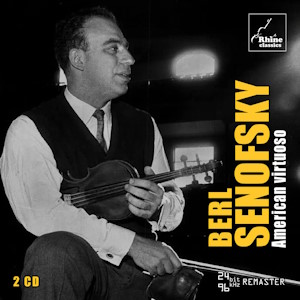
Berl Senofsky (violin)
American Virtuoso
rec. 1955-1980
Rhine Classics RH-030 [2 CDs: 157]
Berl Senofsky (1926-2002) was an American violinist and pedagogue. His teachers were Louis Persinger and later Ivan Gallamian at the Juilliard School of Music. In 1946 Senofsky won the William Naumburg Competition. Between 1951-1955 he served as assistant concertmaster of the Cleveland Orchestra, working under George Szell. In 1955 he won the Queen Elisabeth Competition in Belgium, the first American to do so. He then combined a solo career with one of teaching at the Peabody Conservatory in Baltimore.
Although he didn’t reach the dizzying heights of artists like Heifetz, Stern and Perlman, there’s no denying that Senofsky was a formidable talent and a force to be reckoned with. These valuable aural documents will help bolster a struggling and limited discography. They’ve certainly spurred me on to explore this violinist’s recordings further.
CD 1 is entirely devoted to Brahms, with two Sonatas, Nos. 2 and 3 and the Double Concerto. The Second Sonata derives from a recording set down in Gent in 1980 with pianist Jean-Claude Vanden Eynden. I can’t say I have any particular affection for this performance, which sounds rather wooden and staid to my ears. Senofsky sounds as though he’s just going through the motions, and fails to truly engage with the music. There’s one further problem in the third movement. Two minutes in and for a duration of about 20 seconds, the sound goes awry and becomes very unstable. It’s difficult to ascertain why this is. Generally speaking, I find this performance a rather damp squib. I have, however, no such reservations about the Third Sonata. It’s a live performance from the 1955 Queen Elisabeth competition in Brussels which Senofsky won. The four movement Third Sonata is a much more technically challenging work than its two predecessors. It pleads for dramatic intensity and it gets just that from Senofsky and his partner Claude Franck. The opening movement has vigour, determination and cumulative sweep. The finale, likewise, has plenty of power and energy, and is nothing short of tempestuous. The audience register their approval with enthusiastic applause.
Brahms’ Double Concerto for violin and cello in A minor, Op.102 was recorded live at the Tower Theater, Atlanta in March 1959. Shrley Trepel, one time wife of the violinist, takes up the solo cello role. The orchestra is the Atlanta Symphony Orchestra under Henry Sopkin. It’s a very fine performance indeed, with all concerned singing off the same hymn sheet. Sopkin draws great commitment from the orchestra, and inspires the soloists to give of their best. In the slow movement the soloists blend admirably, savouring the radiant lyricism with heartfelt candour. The finale abounds with energy and passion.
The Mendelssohn, Saint-Saëns and Kreisler works on CD 2 derive from a live concert from the Coolidge Auditorium, Washington on 11 November 1979. Senofsky is partnered by Ellen Mack on piano. Mendelssohn’s F Major sonata was not published until 1953, when Yehudi Menuhin rescued it from obscurity and made a fabulous recording of it with Gerald Moore. The first movement is wonderfully exuberant and life-affirming. The Adagio is a lyrical lied with a hint of wistful regret, eloquently expressed in this reading. The spirited finale has some fine filigree, crisply articulated.
The Saint-Saëns is cast in four movements, and was composed around the time of the Carnival of the Animals suite and the Symphony No. 3 ‘Organ’. The Sonata calls for both eloquence in the lyrical sections and virtuosity. In the opening movement the players capture the underlying tension and drama. In the final movement, which is almost a moto perpetuo, the violinist certainly shows his mettle. The crisp and incisive spiccato is an impressive feature of Senofsky’s gleaming virtuosity, and stands comparison with the two Heifetz recordings. As an encore the violinist announces Kreisler’s Liebeslied which he plays with a tasteful amount of Viennese lilt and charm.
The 1980 Gent recording of Richard Strauss’ Violin Sonata in E-flat major, Op.18 is taken from the same LP as the unsuccessful Brahms Second Sonata discussed earlier. I have to say, I don’t find Jean-Claude Vanden Eynden a very sensitive pianist, but Senofsky is fully in tune with the character and idiom of the work, and plays with great passion and allure. The slow movement fares best. It’s both ardent and tender, and emerges with a luminous glow, especially the central muted section.
Although something of a mixed bag, there’s much to please the Senofsky admirer enshrined in these two discs.
Stephen Greenbank
Availability: Rhine Classics
Contents
CD1
Brahms Violin Sonata No.2 in A major, Op.100
Jean-Claude Vanden Eynden, piano
studio | Gent, V.1980 | LP 33rpm ℗1980
Brahms Violin Sonata No.3 in D minor, Op.108
Claude Frank, piano
live | Brussels, 7.VI.1955
Brahms Double Concerto for violin and cello in A minor, Op.102
Shirley Trepel, cello | Atlanta SO | Henry Sopkin
live | Atlanta, 5.III.1959
CD2
Mendelssohn Violin Sonata No.3 in F major, MWV Q26
Saint-Saëns Violin Sonata No.1 in D minor, Op.75
bis/encore, announce by Berl Senofsky:
Kreisler Liebesleid
Ellen Mack, piano
live | Washinghton D.C., 11.XI.1979
R Strauss Violin Sonata in E-flat major, Op.18
Jean-Claude Vanden Eynden, piano
studio | Gent, V.1980 | LP 33rpm ℗1980


















